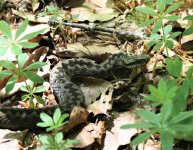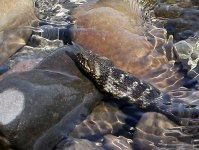You are welcome to join me in this 6th of a series of articles taking a look back over my shoulder at some sightings that have not only delighted us but startled and surprised us.
Hands up everyone who likes snakes! I sense a few of you are hesitating, and if you live in a country with an abundant diversity of snakes including venomous species then this is understandable. In Great Britain (England, Wales and Scotland) we have three species of snake and only one of these is venomous and that is the called the Adder Vipera berus. This is widely distributed throughout Great Britain but is by far most familiar to me and Troubadoris from moors and heaths, so it was with some surprise that we encountered a big male in deciduous woodland in central France. It was in 2015 and we were travelling to the south of France, and broke our journey in the Vercors region, which has the most wonderful variety of flowers. There were gentians and orchids in abundance by the sides of the minor roads and, attracted by a fire-break through some woodland and available parking, we pulled in and wandered around enjoying the forest-edge flowers, especially where a small spring bubbled up and created a tiny marsh.
On the way back to our car we diverted into the wood itself and stopped to discuss our next move, when a minor rustling sound among the forest debris attracted our attention and there, to our great surprise, only a couple of metres away from us, was a fine male Adder, looking less than impressed by our presence. An Adder in woodland! Strange to us, but a look at the distribution map of its presence in GB showed this is not at all unusual. Through my Conquest HD 8x32s it was a truly impressive beastie and had stretched out as if it was going to glide away through the undergrowth, but it stayed where it was, apparently studying us as closely as we were studying him. It seems Adders are blessed with a certain curiosity as well as we humans. We grabbed some photos (see pic 1 below) and then departed quietly, leaving this lovely animal in peace.
A year later in 2016, we encountered another Adder but this time it was a female and only about 5 miles from home. We were visiting a moorland site with a brook running through it which supported a small population of Water Voles and dragonflies. It was while we were standing next to the brook that we noticed a movement on the opposite bank. Through my HT 8x42s I could just make out something moving through the vegetation but couldn’t see what it was until the creature appeared above a tangle of rocks protruding from the bank. It was a big female Adder with a warm colouration quite unlike the grey male we had seen in France. From her vantage point, low on the opposite bank, she must have been able to see us only a few metres away, silhouetted against the sky, but she was not to be put off and began moving down to the water and towards us.
She was clearly not a fan of water because firstly, she chose a crossing place where rocks on both banks shortened the distance, and secondly, instead of slipping nose first into the water at the bottom of the rocks she was slithering down, she cantilevered herself out over the water, reaching as far towards the rocks on our bank as she could, before she reluctantly plopped into the water and swam rapidly to our side of the brook, and disappeared briefly from view, before emerging amongst the vegetation on top of the bank, not far from our feet.
It was amazing to us that although she must have been aware of our presence, she ignored us and simply began sliding along the bank, in and out and under the vegetation while we walked alongside her, only a metre and a half away. She proceeded in this way for about 15 metres and then paused, turning towards us. Can snakes speak? Of course not, but did we get the message that she would prefer us to not be traipsing gaily along alongside her? Yes we did, so we withdrew and left her to get on with her day.
In the following year, 2017, again in France, but this time with me carrying an SF 10x42, we visited several small rivers and streams in our search for additional sites supporting the rare and enigmatic dragonfly Macromia splendens that we had first found in 2015. During our searches of one of these small rivers we came across a water snake (we were unable to identify it to species) that was curiously immobile in the shallows. Through the SFs I could see the reason why: this serpent was swallowing a fish! In pic 2 below you can see not only the bulging of its neck caused by the size of the fish, but also the two points of the fish’s tail fin protruding from the snake’s mouth. Another surprise! In our ignorance we imagined these water snakes ate only frogs and toads, never dreaming that they might be capable of capturing potentially swiftly-accelerating fish. Not wishing to interfere with the snake’s enjoyment of its lunch we departed quietly until we were out of hearing and then just about exploded with our excitement at having witnessed such an event.
Terrific memories, and I hope you enjoyed all three of them.
Lee


Hands up everyone who likes snakes! I sense a few of you are hesitating, and if you live in a country with an abundant diversity of snakes including venomous species then this is understandable. In Great Britain (England, Wales and Scotland) we have three species of snake and only one of these is venomous and that is the called the Adder Vipera berus. This is widely distributed throughout Great Britain but is by far most familiar to me and Troubadoris from moors and heaths, so it was with some surprise that we encountered a big male in deciduous woodland in central France. It was in 2015 and we were travelling to the south of France, and broke our journey in the Vercors region, which has the most wonderful variety of flowers. There were gentians and orchids in abundance by the sides of the minor roads and, attracted by a fire-break through some woodland and available parking, we pulled in and wandered around enjoying the forest-edge flowers, especially where a small spring bubbled up and created a tiny marsh.
On the way back to our car we diverted into the wood itself and stopped to discuss our next move, when a minor rustling sound among the forest debris attracted our attention and there, to our great surprise, only a couple of metres away from us, was a fine male Adder, looking less than impressed by our presence. An Adder in woodland! Strange to us, but a look at the distribution map of its presence in GB showed this is not at all unusual. Through my Conquest HD 8x32s it was a truly impressive beastie and had stretched out as if it was going to glide away through the undergrowth, but it stayed where it was, apparently studying us as closely as we were studying him. It seems Adders are blessed with a certain curiosity as well as we humans. We grabbed some photos (see pic 1 below) and then departed quietly, leaving this lovely animal in peace.
A year later in 2016, we encountered another Adder but this time it was a female and only about 5 miles from home. We were visiting a moorland site with a brook running through it which supported a small population of Water Voles and dragonflies. It was while we were standing next to the brook that we noticed a movement on the opposite bank. Through my HT 8x42s I could just make out something moving through the vegetation but couldn’t see what it was until the creature appeared above a tangle of rocks protruding from the bank. It was a big female Adder with a warm colouration quite unlike the grey male we had seen in France. From her vantage point, low on the opposite bank, she must have been able to see us only a few metres away, silhouetted against the sky, but she was not to be put off and began moving down to the water and towards us.
She was clearly not a fan of water because firstly, she chose a crossing place where rocks on both banks shortened the distance, and secondly, instead of slipping nose first into the water at the bottom of the rocks she was slithering down, she cantilevered herself out over the water, reaching as far towards the rocks on our bank as she could, before she reluctantly plopped into the water and swam rapidly to our side of the brook, and disappeared briefly from view, before emerging amongst the vegetation on top of the bank, not far from our feet.
It was amazing to us that although she must have been aware of our presence, she ignored us and simply began sliding along the bank, in and out and under the vegetation while we walked alongside her, only a metre and a half away. She proceeded in this way for about 15 metres and then paused, turning towards us. Can snakes speak? Of course not, but did we get the message that she would prefer us to not be traipsing gaily along alongside her? Yes we did, so we withdrew and left her to get on with her day.
In the following year, 2017, again in France, but this time with me carrying an SF 10x42, we visited several small rivers and streams in our search for additional sites supporting the rare and enigmatic dragonfly Macromia splendens that we had first found in 2015. During our searches of one of these small rivers we came across a water snake (we were unable to identify it to species) that was curiously immobile in the shallows. Through the SFs I could see the reason why: this serpent was swallowing a fish! In pic 2 below you can see not only the bulging of its neck caused by the size of the fish, but also the two points of the fish’s tail fin protruding from the snake’s mouth. Another surprise! In our ignorance we imagined these water snakes ate only frogs and toads, never dreaming that they might be capable of capturing potentially swiftly-accelerating fish. Not wishing to interfere with the snake’s enjoyment of its lunch we departed quietly until we were out of hearing and then just about exploded with our excitement at having witnessed such an event.
Terrific memories, and I hope you enjoyed all three of them.
Lee






